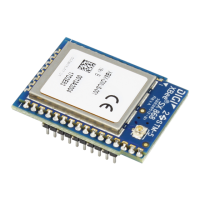Sleep modes Sleep coordinator sleep modes in the DigiMesh network
XBee® SX 868 RF Module User Guide
107
Synchronous pulse
The Synchronous pulse feature supports user applications that desire synchronizing operations across
multiple devices in a network. This is done by pulsing the DIO9—ON_SLEEP—pin simultaneously on all
devices in the network. Typically, this feature is used with a mains-powered application and
transmissions are not inhibited except during the small window of time allocated for sending
synchronization messages throughout the network.
Configuration
Generally, synchronous pulse is configured the same way as synchronous sleep. See the table below:
AT
Command Value Description
D9 6 This causes a synchronous pulse line to be toggled low and then high on
the DIO9 pin throughout the network. Note that D9 must be set to 1 for the
ON_SLEEP indicator. This means that it is not possible to have both a
synchronous pulse and an ON_SLEEP indicator. However, if a synchronously
sleeping network is desired, D9 may still be used as a synchronous pulse
with the obvious limitation that the network will not be able to transmit
while it is asleep.
SM 7 or 8 Setting SM to 7 or 8 allows the synchronization messages to be sent. They
will not be sent and this feature will be disabled if SM is set to any other
value.
SP 0 Even with SM set to 8, the network still stays awake by setting SP to 0 on
the sleep coordinator.
ST ?? Set ST to the frequency desired for the synchronous pulse. If it is set too
small, it is rounded up to a value that allows a synchronous pulse to be
output every time DIO9 pulses. Some parameters—such as NH—can be
made smaller in order to reduce the minimum value for ST. If it still is not
possible to get synchronous pulses at small enough intervals to satisfy the
application, then the microcontroller connected to DIO9 will be responsible
for subdividing the time between each synchronous pulse.
Accuracy
Due to variations is traffic patterns and hopping patterns, perfect accuracy cannot be guaranteed.
However, this feature is usually accurate within + or - 100 micro-seconds. If greater accuracy than that
is required, this solution will not work for your application.
Start a sleeping synchronous network
By default, all new nodes operate in normal (non-sleep) mode. To start a synchronous sleeping
network, follow these steps:
1. Set SO to 1 to enable the preferred sleep coordinator option on one of the nodes.
2. Set its SM to a synchronous sleep compatible mode (7 or 8) with its SP and ST set to a quick
cycle time. The purpose of a quick cycle time is to allow the network to send commands
quickly through the network during commissioning.

